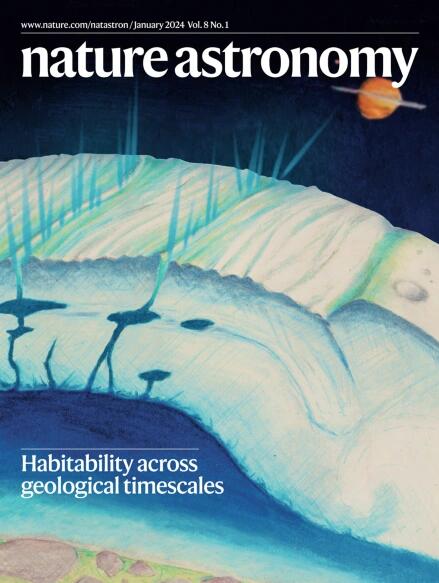银河系和仙女座星系的碰撞还不确定
IF 14.3
1区 物理与天体物理
Q1 ASTRONOMY & ASTROPHYSICS
引用次数: 0
摘要
人们普遍认为,我们的银河系正处于与邻近的仙女座星系碰撞的轨道上。据预测,在大约50亿年后,构成本星系群的两个大型螺旋星系合并的结果将形成一个新的椭圆星系。在这里,我们考虑了盖亚和哈勃太空望远镜最新和最准确的观测结果,以及最近的共识质量估计,以得出可能的未来情景,并确定本星系群在未来100亿年内进化的主要不确定性来源。我们发现,下一个最大的本星系群成员星系——即M33和大麦哲伦星云——明显而彻底地影响了银河系-仙女座的轨道。虽然M33的加入增加了合并的可能性,但大麦哲伦星云的轨道与银河系-仙女座的轨道垂直,使得它们合并的可能性更小。在整个系统中,我们发现所有星系目前的位置、运动和质量的不确定性为截然不同的结果留下了空间,在未来100亿年内,银河系和仙女座星系合并的概率接近50%。根据现有的最佳数据,我们银河系的命运仍然是完全未知的。本文章由计算机程序翻译,如有差异,请以英文原文为准。


No certainty of a Milky Way–Andromeda collision
It is commonly believed that our own Milky Way is on a collision course with the neighbouring Andromeda galaxy. As a result of their merger, predicted in around 5 billion years, the two large spiral galaxies that define the present Local Group would form a new elliptical galaxy. Here we consider the latest and most accurate observations by the Gaia and Hubble space telescopes, along with recent consensus mass estimates, to derive possible future scenarios and identify the main sources of uncertainty in the evolution of the Local Group over the next 10 billion years. We found that the next most massive Local Group member galaxies—namely, M33 and the Large Magellanic Cloud—distinctly and radically affect the Milky Way–Andromeda orbit. Although including M33 increases the merger probability, the orbit of the Large Magellanic Cloud runs perpendicular to the Milky Way–Andromeda orbit and makes their merger less probable. In the full system, we found that uncertainties in the present positions, motions and masses of all galaxies leave room for drastically different outcomes and a probability of close to 50% that there will be no Milky Way–Andromeda merger during the next 10 billion years. Based on the best available data, the fate of our Galaxy is still completely open. It is widely believed that the Milky Way is set to collide with Andromeda, its nearest neighbour. New calculations using data from Hubble and Gaia that account for the effects of other galaxies show an almost 50% chance of our Galaxy avoiding this fate.
求助全文
通过发布文献求助,成功后即可免费获取论文全文。
去求助
来源期刊

Nature Astronomy
Physics and Astronomy-Astronomy and Astrophysics
CiteScore
19.50
自引率
2.80%
发文量
252
期刊介绍:
Nature Astronomy, the oldest science, has played a significant role in the history of Nature. Throughout the years, pioneering discoveries such as the first quasar, exoplanet, and understanding of spiral nebulae have been reported in the journal. With the introduction of Nature Astronomy, the field now receives expanded coverage, welcoming research in astronomy, astrophysics, and planetary science. The primary objective is to encourage closer collaboration among researchers in these related areas.
Similar to other journals under the Nature brand, Nature Astronomy boasts a devoted team of professional editors, ensuring fairness and rigorous peer-review processes. The journal maintains high standards in copy-editing and production, ensuring timely publication and editorial independence.
In addition to original research, Nature Astronomy publishes a wide range of content, including Comments, Reviews, News and Views, Features, and Correspondence. This diverse collection covers various disciplines within astronomy and includes contributions from a diverse range of voices.
 求助内容:
求助内容: 应助结果提醒方式:
应助结果提醒方式:


